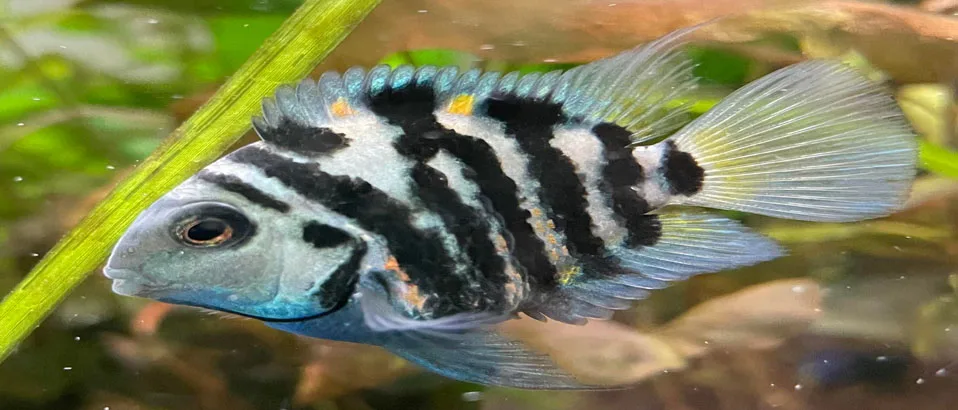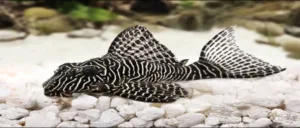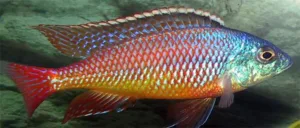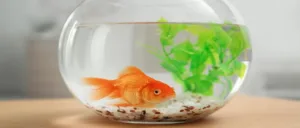Among aquarium enthusiasts, the Polar Blue Parrot Fish (or Polar Blue Parrot Cichlid) has become very popular in a short period. This charming species is not only an ecological marvel but also an entertaining addition to freshwater aquarium fish. The bright blue color of this fish reminds one of tropical oceans, which makes it outstanding in any aquatic setting. The Polar Blue Parrot Fish attracts people with different levels of experience who love them for their beauty and unique behavioral patterns.
The Polar Blue Parrot Fish being strong and good-looking at the same time owes its origin to crossbreeding between various cichlid species that were bred in captivity. A broad range of color patterns and resistance to diseases have been developed as a result of this interbreeding so that they can live under various water conditions mainly on the fresh side.
More than just looking pretty, these fish have another side – their behavior; they like to keep busy! In well-maintained tanks with clean water, you will see these beautiful cichlids sifting through gravel gently using their beak-like mouths. Polar blue parrot cichlids are often seen playing around with other tank mates in a playful manner. With such characters as theirs, it is no wonder why home aquarists find them irresistible additions into their decorative waterscapes.
The Polar Blue Parrot Fish serves not only as a living piece of art but also as a captivating participant in the aquatic ecosystem of any home. As we delve deeper into the specifics of their care, habitat requirements, and compatibility with other species, it becomes evident why the Polar Blue Parrot Fish is considered a gem within the aquarium community.
Natural Habitat and Origin of Polar Blue Parrot Cichlids
This stunning creature does not come from any natural environment as such since it was selectively bred by aquarium hobbyists over generations upon generations. The Polar Blue Parrot Cichlid is a hybrid species resulting mainly from crossing the Blood Parrot Cichlid with other cichlid types, possibly including the convict cichlid. The lineage may vary thus contributing towards various colours and temperaments observed among individuals within this group. Unlike wild-caught fish, which have spent their entire lives in rivers or lakes before being captured for sale in shops; these beautiful creatures were brought into existence within our tanks!
If an aquarist wants to create a perfect habitat for Polar Blue Parrot Fish, they should strive for balance within the tank. This means that water temperature, pH levels and hardness ought to be similar to those found in natural habitats of cichlids. Optimal conditions include a range of temperatures from 76°F to 80°F, slightly acidic or neutral pH (around 6.5-7.5) and medium hard water. The tank itself should be decorated with substrates resembling sandy or rocky bottoms typically seen in cichlid environments along with caves and crevices where they can hide.
Distinctive Physical Characteristics and Color Variations
What sets polar blue parrots apart from other inhabitants of aquariums are their physical peculiarities as well as striking colour variations. These characteristics are obtained through hybridization – mixing traits derived from various species of cichlids into one visually captivating package.
| Characteristic | Description |
|---|---|
| Body Shape | Rounded with a large, parrot-like beak, which is actually a fusion of the upper and lower parts of the mouth. |
| Size | Typically 4 to 6 inches in length when fully mature, though they can grow larger with optimal care. |
| Fins | Broad and rounded fins, with the dorsal and anal fins being almost symmetrical. |
| Eyes | Relatively large and expressive, set forward on the head, giving them a perceptive appearance. |
These physical attributes not only contribute towards aesthetic value but also affect behaviour and interaction within the tank environment among themselves or with other fish species that may co-exist together in same ecosystem . For instance; unique shape of mouth influences what kind food they eat easily.
| Color Pattern | Description |
|---|---|
| Solid Blue | A deep, vibrant blue covering the entire body, which is the most common and sought-after coloration. |
| Blue with Black Markings | Blue base with irregular black markings or patches, often appearing on the fins or along the back. |
| Mottled Blue and White | A mix of blue and white blotches that create a marbled effect across the body. |
| Fading Blue | Lighter blue that gradients into almost white or pale blue, typically more pronounced in younger fish. |
The difference of colours is not only due to genes passed down through generations but can also be affected by diet, water parameters and general healthiness status . When fit living conditions are met bright vibrant colours will always show up unlike cases where stress or sicknesses prevail which result into dullness of pigments.
Behavioral Patterns and Social Habits of Polar Blue Parrot Fish
In an aquarium setting , these creatures exhibit wide range fascinating behavior patterns. Some of these behaviours could tell us a lot about how healthy these cichlids are likely to be hence giving more insights on what should be done so as to keep them healthy always.
Social Interaction
One thing most people know about polar blue parrot is that they are social species which means they love company from their kind and any other fish sharing same space with them. However, this does not mean all individuals will behave socially towards each other. Depending on environment or individual temperaments, some polar blues may turn out be more territorial than others especially when kept in small tanks or overcrowded conditions.
Communication
These fish communicate with other tank mates by changing their body positions, colours, and fin movements. They also known to use their body language to establish social hierarchies within their groupings. Observing these signals can be crucial for aquarists to ensure a healthy tank environment.
Feeding Behavior
Another interesting feature that makes them unique apart from other fishes is shape of their mouth. Polar Blue Parrot Cichlids have got an interesting beak-like structure that plays significant role in their feeding behaviour. They like picking up tiny organisms crawling along hard surfaces therefore aquarists should provide enough hiding places where insects could hide. In addition, their diet varies depending largely upon availability but mainly consists of live foods such as crustaceans (shrimps etc.), worms or even small fishes since these are what they eat mostly both in captivity and wild environments.
Playfulness and Curiosity
Their playful behaviour and curiosity are some of the most charming qualities that Polar Blue Parrot Fish possess. They frequently investigate tank ornaments, swim through tunnels or among plants and sometimes appear to play with elements of their environment. Such a high level of curiosity makes them great pets because it often seems like they are always finding out about where they live.
Adaptability
Lastly, their adaptability is a significant part of their behavior. Polar Blue Parrot Fish are strong fish that can adjust to various tank conditions despite having originated from hybrids. This shows how resilient they are since even when there is a change in the surroundings, these fish still manages well with it. However, this does not mean that one should forget about keeping stable water conditions as this is important for long-term health and bright colors.
In general, what makes Polar Blue Parrot Fish interesting for study or addition into any home aquarium is its behavioral patterns together with social habits. Having them around can greatly improve an aquarium by making it more alive thus giving owners infinite points for observation and enjoyment.
Aquarium Care for Polar Blue Parrot Fish
Tank setup, water quality management, feeding requirements and health monitoring are among key things needed to give perfect care for these fish while at home setting. All these elements contribute significantly towards ensuring that such lively organisms thrive within domestic tanks.
Setting Up the Right Environment
Tank Size and Layout: For Polar Blue Parrot Fish, a minimum tank size of 30 gallons is recommended to ensure they have enough space for swimming and displaying natural behaviours. Bigger tanks are better, especially if keeping multiple individuals or tank mates. The arrangement of the tank should have lots of hiding spots and territories which can be made using rocks, caves and plants. This setup not only imitates their natural habitat but also helps in calming down stress levels among fish.
Water Quality and Parameters: Keeping clean water conditions is very important for the health of Polar Blue Parrot Fish. The water temperature should be maintained between 76 to 80°F with pH level ranging from 6.5-7.5. Regular water changes (at least 25% every two weeks) are necessary to keep off toxins that might make the water dirty. Good filtration also ensures clarity of water as well as aeration.
Diet and Nutrition
Dietary Requirements: Polar Blue Parrot Fish are omnivorous hence they need a balanced diet comprising both plant-based foods and those derived from animals. High quality cichlid pellets ought to form the main part of their meals while fresh vegetables like peas & spinach may be added occasionally as supplements. Treats such as brine shrimp or bloodworms can be given sometimes too. This diverse menu plays a vital role in keeping up their bright coloration besides overall well being.
Feeding Practices: They should be fed twice daily in small quantities so that their food is consumed within few minutes. Overfeeding can cause obesity which may lead to other health problems such as digestive disturbances besides affecting quality of water.
Monitoring and Health Care
Common Health Issues: Polar blue parrot cichlid fish often get infected by ich, fin rot or bacterial infections which are known to affect them more than any other type; thus early diagnosis plus treatment should be given on priority so as to control those conditions. Lethargy, loss of appetite, abnormal swimming behavior and presence of visible spots or lesions on body are some signs indicating that fish has fallen ill.
Stress Reduction: Stress can greatly impact the overall condition of these cichlids therefore it is important for aquarists to create a conducive environment where they will feel safe. This can be achieved through ensuring stability in all aspects including noise reduction near tanks and sudden movements around them. Regularly checking water parameters is also important. Compatibility with tank mates should be carefully considered to avoid aggressive interactions.
Looking after Polar Blue Parrot Fish correctly involves not only fulfilling basic requirements but also setting up an environment where they can display natural behaviors and flourish. Paying attention to details concerning their diet, tank conditions and health monitoring ensures that these lovely creatures remain lively throughout their stay within our aquariums.
Breeding Polar Blue Parrot Fish
The fact that hybrids have been created makes breeding captive-bred ones somehow difficult though achievable too. Ideally, one should try out controlled conditions during breeding process where factors like temperature, light intensity or pH level are maintained at specific values. Slightly elevating water temperatures while providing diets full of nutrients might induce late springtime breeding instincts which mark typical spawning period for these fishes.
To stimulate spawning, provide many hiding places and substrate for egg laying. Polar Blue Parrot Fish guard their eggs and fry so it is important to watch the tank and make sure no parents or other tank mates are disturbing the spawning area.
Choosing Compatible Tank Mates
While Polar Blue Parrot Fish are generally peaceful, their compatibility with other fish depends on several factors, including the size of the tank, the nature of other species, and individual temperaments. Ideal companions would therefore include other non-aggressive types that do not compete with them for food or territory. Larger tetras, barbs, or cichlids that prefer similar water conditions might fit this bill.
Coral Compatibility
In setups where aquarists try to create a more brackish environment, it’s crucial to choose corals and plants that can thrive under similar conditions. Non-stinging corals and robust plants that can tolerate slight fluctuations in water quality are best suited for tanks with Polar Blue Parrot Fish.
Community Tank Considerations
When planning a community tank with Polar Blue Parrot Fish it is important to consider both vertical and horizontal space available within the aquarium set up. These fish often occupy middle to bottom layers hence upper layers need to be populated by other species too but without overstocking them together thereby ensuring all areas are utilized.
Maintenance and Troubleshooting for Polar Blue Parrot Fish
Maintaining an aquarium with Polar Blue Parrot Fish involves diligent care and routine checks to ensure that the aquatic environment remains stable and healthy. Effective troubleshooting strategies are crucial for promptly addressing any issues that arise, thus preserving the health of the fish and the aesthetic of the tank.
Troubleshooting Common Issues
Algae Overgrowth: Algae growth is a common problem in many aquariums owing to excessive light or nutrients. This problem can be controlled by regulating light exposure, balancing nutrient levels and regular water changes. Another method includes introducing algae-eating fish or snails as biological control agents.
Cloudy Water: Cloudy water results from bacterial blooms, overfeeding, or poor filtration. Feed less, increase filtration and enhance water circulation to resolve this. If it persists a partial water change may have to be done until the clarity is restored.
Behavioral Changes: When polar blue parrot fish stop eating or become inactive, there could be underlying stress or ill-health conditions. Check for any changes in water parameters and inspect the fish for visible signs of disease. To tackle these troubles an alteration of tank surroundings might be done or otherwise you can consult a vet who is specialized in fish management.
Compatibility Issues: Territorial disputes such as aggression can arise when new tank mates are introduced, thus rearranging the tank to break up established territories would be helpful, also if necessary you could withdraw any aggressive individual into another tank.
Conclusion
Polar Blue Parrot Fish are an amazing opportunity to bring color and liveliness into your own living room aquarium. They are delightful additions to your collection that will provide endless fascination in your underwater world over many years if properly cared for.
FAQs about Polar Blue Parrot Fish
Q1: What is the ideal tank size for Polar Blue Parrot Fish?
A1: The ideal tank size for Polar Blue Parrot Fish is 30 gallons minimum since this affords adequate space for free swimming and natural behavior. When keeping more than one fish or community tanks, larger tanks may be required to avoid fights over territories or stress.
Q2: What are the best conditions for Polar Blue Parrot Fish in terms of water parameters?
A2: Water temperature range between 76-80°F with pH levels ranging from 6.5-7.5 is ideal for Polar Blue Parrot Fish. The water should be slightly acidic to neutral. Regular monitoring and adherence to these parameters is vital if they are to remain healthy.
Q3: What should I feed my Polar Blue Parrot Fish?
A3: These parrots are omnivorous needing a variety of both plant and animal materials in their diets. A diet for these fish needs to comprise mostly of high quality cichlid pellets and supplemented with occasional vegetables such as peas and carrots, brine shrimp or bloodworms, cooked fish. Proper feeding ensures nutritional balance and helps maintain their vibrant coloration.
Q4: How often should I change the water in my Polar Blue Parrot Fish tank?
A4: Every two weeks, a 25-30% water change is recommended. This cleaning schedule ensures that chemical substances harmful to fish are avoided.
Q5: Can Polar Blue Parrot Fish live with other species?
A5: Yes, they can coexist with other non-aggressive fish species that require similar water conditions. For instance, suitable tank mates for them include larger tetras and barbs while some people prefer adding more cichlids. Regular monitoring of tank behavior will ensure there are no signs of stress or aggression.
Q6: Are Polar Blue Parrot Fish suitable for beginners?
A6: Due to their hardy nature and adaptability, these fishes may be chosen by even those who have just started keeping aquariums. Nonetheless, potential owners must know how to keep them in terms of size of the tank required, quality of water and diet so they will provide an adequate environment.
Q7: What are common health issues for Polar Blue Parrot Fish?
A7: A few of the most common health problems experienced by Polar Blue Parrot Fish are ich, fin rot and bacterial infections.
Q8: How can I tell if my Polar Blue Parrot Fish is stressed?
A8: Some signs of stress in Polar Blue Parrot Fish are hiding out more than usual, eating less food, swimming erratically or rubbing against objects in the tank. The main causes of stress could be poor water quality, wrong tank mates or poor condition of tanks. Addressing the issues behind them on time is very crucial for their good health.
Q9: How long do Polar Blue Parrot Fish live?
A9: With proper care, these fish can live up to ten years or more. Their life span depends on many factors such as diet and overall management of their environment.
Q10: Can Polar Blue Parrot Cichlids breed in captivity?
A10: Breeding Polar Blue Parrot Cichlid in captivity can be a challenging thing to do, but it is possible with right conditions. An optimal breeding setup where water temperatures are right, food is provided well as well as an appropriate tank set up will trigger breeding behavior among them.
Q11: How big do Polar Blue Parrot Fish get?
A11: Polar Blue Parrot Fish typically reach about 4 to 6 inches in length when fully grown. Their growth can be influenced by factors such as tank size, diet, and overall health. Providing ample space and optimal nutrition can help them achieve their full size potential.
Q12: How often do Polar Blue Parrot Fish lay eggs?
A12: The frequency at which egg-laying occurs depends on tank conditions. In optimal breeding conditions, however, Polar Blue Parrot Fish spawn multiple times annually. It is important to note that environmental factors such as water temperature, quality and a suitable breeding habitat play a big role in encouraging spawning.
Q13: How to identify male and female Polar Blue Parrot Fish?
A13: Identifying males and females among these fish is difficult since they exhibit no external sexual dimorphism. However, males are generally bigger and during reproductive seasons their color may tend to be slightly more vivid than usual. During mating periods, observing the behavior of this type of fish helps because it would help identify territorialism in males who might also engage in courtship displays through increased activity levels.
Q14: How to breed Polar Blue Parrot Fish?
A14: To breed them one should increase water temperature by several degrees (like around 80°F) while keeping it clean and sufficiently filtered. Feed them high nutrition food before breeding. Create flat surfaces or caves where the females can deposit their eggs. Observe the fish for signs of pairing and nesting, and once eggs are laid, consider separating parents from eggs if there is a risk of predation.
